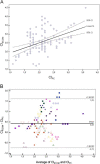Can endotracheal bioimpedance cardiography assess hemodynamic response to passive leg raising following cardiac surgery?
- PMID: 22784815
- PMCID: PMC3425133
- DOI: 10.1186/2110-5820-2-26
Can endotracheal bioimpedance cardiography assess hemodynamic response to passive leg raising following cardiac surgery?
Abstract
Background: The utility of endotracheal bioimpedance cardiography (ECOM) has been scarcely reported. We tested the hypothesis that it could be an alternative to pulse contour analysis for cardiac index measurement and prediction in fluid responsiveness.
Methods: Twenty-five consecutive adult patients admitted to the intensive care unit following conventional cardiac surgery were prospectively included and investigated at baseline, during passive leg raising, and after fluid challenge. Comparative cardiac index data points were collected from pulse contour analysis (CIPC) and ECOM (CIECOM). Correlations were determined by linear regression. Bland-Altman analysis was used to compare the bias, precision, and limits of agreement. Percentage error was calculated. Changes in CIPC (ΔCIPC) and CIECOM (ΔCIECOM) during passive leg raising were collected to assess their discrimination in predicting fluid responsiveness.
Results: A significant relationship was found between CIPC and CIECOM (r = 0.45; P < 0.001). Bias, precision, and limits of agreement were 0.44 L.min-1.m-2 (95% confidence interval, 0.33-0.56), 0.59 L.min-1.m-2, and -0.73 to 1.62 L.min-1.m-2, respectively. Percentage error was 45%. A significant relationship was found between percent changes in CIPC and CIECOM after fluid challenge (r = 0.42; P = 0.035). Areas under the ROC curves for ΔCIPC and ΔCIECOM to predict fluid responsiveness were 0.72 (95% confidence interval, 0.5-0.88) and 0.81 (95% confidence interval, 0.61-0.94), respectively.
Conclusions: ECOM is not interchangeable with pulse contour analysis but seems consistent to monitor cardiac index continuously and could help to predict fluid responsiveness by using passive leg raising.
Figures




References
LinkOut - more resources
Full Text Sources
Miscellaneous

